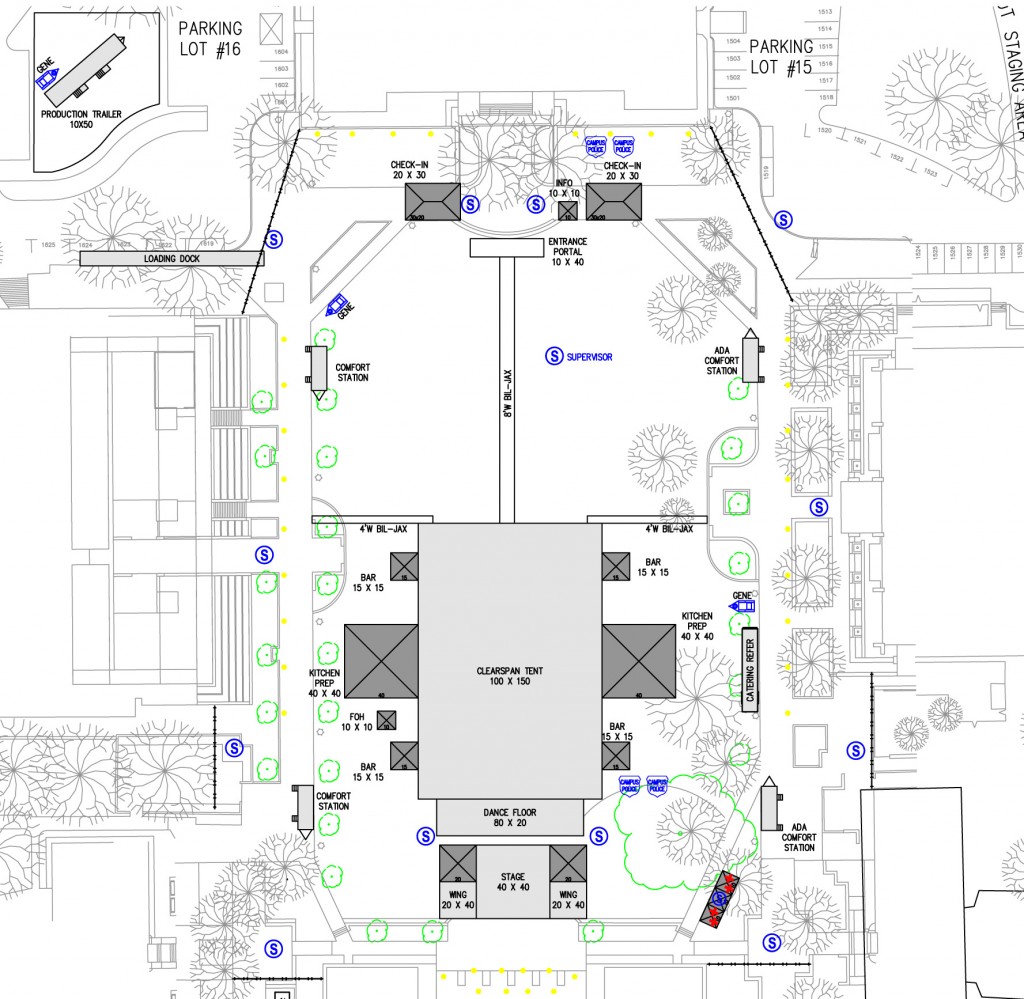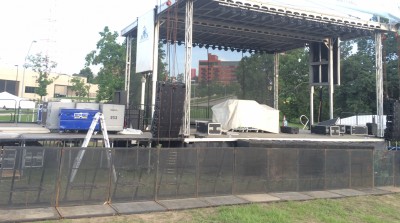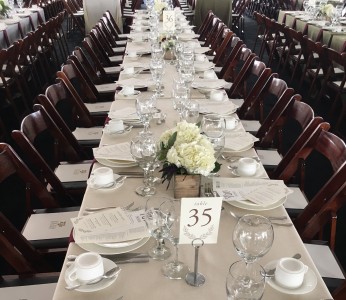Site Operations Guide
Site Operations encompasses everything from map design to forklift usage to port a let placement. While smaller events can often tie Production and Site needs together, most medium events and virtually all festivals need a separate Site Operations Manager with a site crew. Below you will see everything that makes up Site Operations and how to best plan for your event and festival site needs. And remember, always keep your site crew happy enough to give you a thumbs up.
- Overview of Site Operations
- General scope of work for an event or festival
- Indoor Event – do they have everything you need or will you need to rent port a lets, fencing, bike rack, and the like? Often, indoor venues (especially for smaller events) have just about everything you need.
- Outdoor Event – assess how much the space provides in terms of restrooms, fencing, power, lighting, and other site elements.
- Outdoor Multi-Day Festival – in addition to the regular site needs you’ll want to consider having extra materials in case things break, fuel trucks or containers at the ready when generators and vehicles need gas.
- Outdoor Camping Festival – in addition to the regular festival needs, you will want to consider extra port a lets, showers, overnight teams, lighting, and other needs associated with having guests on-site 24/7 and resources being used constantly.
- General scope of work for an event or festival
- Site Mapping / CADs
- Site maps are essential to the planning and execution of an event or festival build. CADs are preferred to build site maps in as they can be built to scale and are easy to understand, giving you exact dimensions and measurements to work from. Then, you can hand these maps out to your team and give them the ability to execute the site layout. You will want to show some of the following elements on a site map:
- Event Offices
- Bike Rack / Fence lines
- Generators
- Stages
- Tents
- Front Gates
- Portalets and/or Comfort Stations
- Dumpsters
- Parking areas / loading zones
- Boneyard (storage for on-site gear)
- Security Positions (see our Security Guide for more details)
- Festivals and Events will also often have a public version of their site maps, which may not show all of the site operations details, but will often show the major elements of the festival. Below is an example of a public site map:
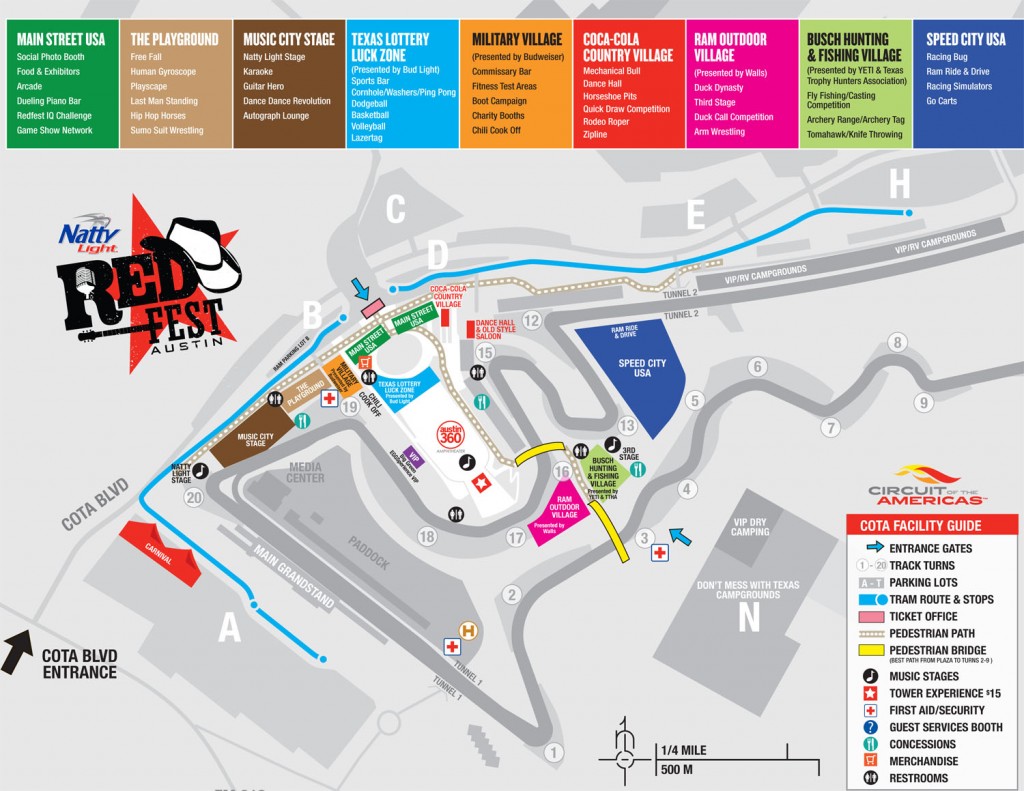
RedFest 2014 Site Map
- Site maps are essential to the planning and execution of an event or festival build. CADs are preferred to build site maps in as they can be built to scale and are easy to understand, giving you exact dimensions and measurements to work from. Then, you can hand these maps out to your team and give them the ability to execute the site layout. You will want to show some of the following elements on a site map:
- Fencing / bike rack
- Determining and then measuring all needed fencing and bike rack
- When to fence and when to bike rack – factor in privacy needs, type of crowd, any regulations associated with serving alcohol, and overall look & feel of the event
- Other options (lattice fencing, riot fencing, steel gates) – for some very large, young crowds that aren’t afraid to try and hop the fence to sneak in, 10+ foot tall steel riot fencing and steel gates may be the best solution. For VIP areas and more laid-back events, 2 foot tall lattice fencing does the job of sectioning off the desired area without being too obtrusive.
- Flow-through barricade
- Determining when to use this instead of bike rack: if the crowd is one that isn’t going to be prone to compression or trying to rush the stage, and the band, city, or venue owner doesn’t require it, bike rack may be sufficient for crowd control around the stages and other high traffic areas. Industry standard for most large festivals, stadium / arena concerts, and amphitheaters is the use of flow-through barricade at the pit of the stage.
- Determining if flow through barricade are also needed for front gate crowd control – for larger crowds, it may necessitate a stronger entry and exit point for security to better process everyone coming and going.
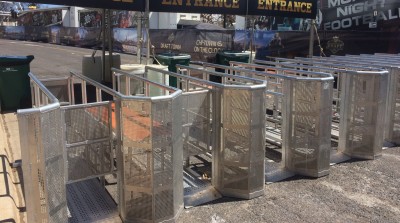
- Portalets / Comfort Stations
- Determining the proper amount of portalets given your crowd size
- General rule of thumb is 1 portalet per every 100-120 people if it is a daytime / non-camping show
- Factoring in best placement of the portalets to allow for the best balance of guest experience versus site layout / traffic flow (i.e., placing the majority of portalets on one side of the park, the food / art / bar areas in the middle, and the stage on the other side, so all of those areas will see decent traffic)
- Placing them so they are easily pumped / serviced
- Ensuring you have the proper amount of ADA portable toilets and that they can be easily accessed by the disabled
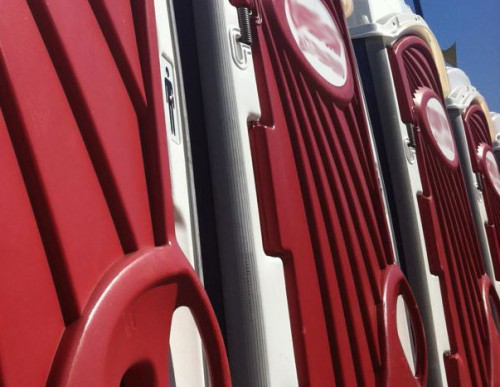
Gorgeous.
- Determining the proper amount of portalets given your crowd size
- Tents / Tables / chairs / linens / pipe & drape
- Determining how many event elements need these items and how to best order and distribute them – this will often be a result of the overall vision of the event, the event budget, and the availability of the elements.
Assigning a specific site crew person to handle all of the table / tent / chair needs along with a crew to help execute is a common way to handle the build; alternatively, most tent vendors will provide turnkey labor if that is desired.
- Some events will include these items for vendors and sponsors; others require them to bring their own.
- Common table sizes:
- Common linen sizes:
- 90×156 – for 8′ tables
- 90×132 – for 6′ tables
- 90″ Round
- 108″ Round
- 120″ Round
- 132″ Round
- Add more sizes
- Common Tent sizes and styles:
- 10×10 Frame Tent / Peaked Roof (“Festival Style”) Tent
- 10×20
- 20×20
- 20×40
- 40×40

20×20 Peaked Roof Style (Courtesy of Marquee Tents)
- Larger Clearspan Tents:
- Various sizes
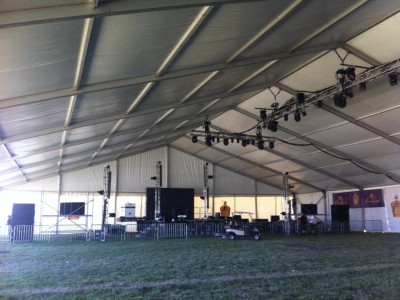
Inside of a 300×80 Clearspan tent at Country Thunder 2013
- Various sizes
- Tent Accessories:
- Tent walls – clear, with windows, or solid
- Interior lighting – par cans, LEDs, or string lighting
- Staking vs. using water barrels
- Determining how many event elements need these items and how to best order and distribute them – this will often be a result of the overall vision of the event, the event budget, and the availability of the elements.
- Setting Chairs with exact pitches / dimensions
- Power for the entire site
- Determine the event’s power needs and then work with the power vendor to have a placement of generators and power distro that allows for discrete locations that can still properly reach everyone who needs power.
- Make sure you also have enough cable ramps and that the cables will properly fit inside them.
- May also need to bike rack / fence off generators that are inside the public areas.
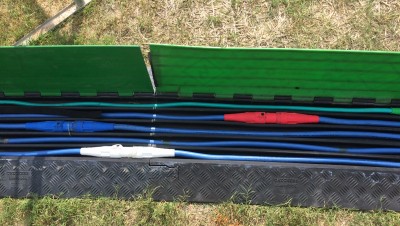
- Fire Safety Requirements for Site
- Be sure to be completely familiar and in compliance with any and all local fire codes / ordinances. There are two national model codes – the International Fire Code (IFC) and the National Fire Protection Association’s model fire code (NFPA 1).
- All ingress and egress must be unobstructed, of an approved minimum width, and able to provide a safe escape if necessary (i.e., a stairway that can withstand a certain weight threshold).
- ADA requirements need to be taken into account here as well.
- Fire Extinguishers need to be placed at all required places as determined by the local fire marshall’s office and/or existing fire codes. Common examples around an event or festival site include:
- Onstage (may need multiple types if there is cryo / pyro / compressed gas tanks as part of the performance)
- Inside tents that are larger than 400 sq feet (20×20) with no walls or larger than 100 sq feet (10×10) with walls
- Spread out evenly among food vendors at food courts
- Near any generators
- Near parking lots, especially if the lots are grass / dirt
- Classes of Fires:
- Class A – the most likely type to occur at events and festivals – involves materials like paper, wood, rubber, or fabrics.
- The best type of fire extinguisher for these kinds of fires is a water or foam based extinguisher.
- Class B – involves flammable liquids like gas, oil, paint and flammable gasses. If your event has any pyro, cryo, or anything involving tanks of gas, you will need to protect yourself against this type of potential fire.
- The best type of fire extinguisher for these kinds of fires is a CO2 / chemical based extinguisher, but foam extinguishers could also be beneficial here.
- Class C – involves live electrical equipment (generators, transformers, lighting gear, audio gear, etc)
- The best type of fire extinguisher for these kinds of fires is a Co2 / chemical based extinguisher.
- Class D – involves combustible metals like sodium or lithium. Events and festivals won’t likely see any fires from this class, but if so, salt-based chemicals will be needed to extinguish them.
- Class K – involve fires in cooking ovens and other cooking appliances which involve cooking related materials like vegetable oils or fats. Wet chemical fire extinguishers that include a low pH agent help prevent grease splash and fire flare ups while bringing the fire and heat under control.
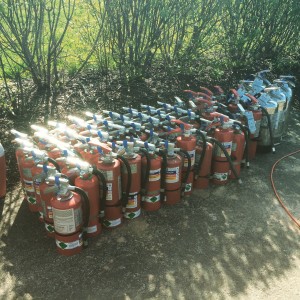
Various types of water based and Co2 based extinguishers in an event boneyard, ready for deployment.
- Class A – the most likely type to occur at events and festivals – involves materials like paper, wood, rubber, or fabrics.
- Site Lighting – light towers, other kinds
- Determine how many light towers you may need in order to properly light up your event at night; take into consideration any bleeding that may affect the guest experience (i.e., you don’t want light towers shining backstage where people out front can see them, but backstage still needs to be lit properly)
- Place light towers on a map and work with your vendor to ensure they are all installed properly, that the bulbs are all working, and that there is a plan for refueling
- Heavy machinery (lull, boom, shop fork, etc)
- Determine what sort of heavy machinery needs exist not only in the Site Ops department but also the Production department
- Order the proper amount of forklifts given projected site needs; most forks are needed for moving around pallets of goods, plywood, lifting up truss / scaffold, and reaching places to install signage and site lighting
- You may need to order larger forks if the loads demand; usually forks that have a capacity of 5k, 6k, or 10k are the norm.
- For smaller events, or events that are on asphalt / concrete, a shop fork could suffice. They are usually 5k or less and work fine; they just can’t drive on dirt or grass.
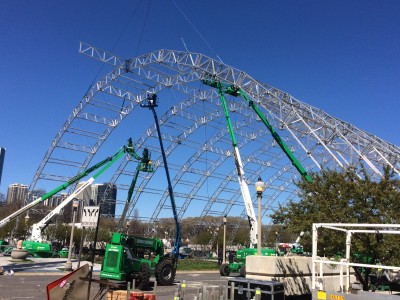
- Determine what sort of heavy machinery needs exist not only in the Site Ops department but also the Production department
- Ground protection – plywood, aluminum rolls
- Determine how much ground protection you will need – this is done by finding out the needs / requirements of the site (some parks, for example, now require all vehicles driving on the grass to drive over ground protection).
- For needs where plywood won’t suffice, look for aluminum rolls – with the help of a crew and a forklift, you can roll these out as needed and have trucks as large / heavy as semis drive on them.
- ADA Considerations
- What needs to be included in order to be compliant with the Americans with Disabilities Act? The ADA act of 1990 is a Federal law that prohibits, under certain circumstances, discrimination based on disability.
Of the five major sections in the ADA, the two that apply to most events and festivals are:
- Title II – Public Entities – prohibits disability discrimination by all public entities at the local and state level as well as public transportation provided by public entities.
- Title III – Public Accomodations – no individual may be discriminated against on the basis of disability concerning the full and equal enjoyment of the goods, services, facilities, or accommodations of any place of public accommodation by any person who owns, leases, or operations a place of public accommodation.
Compliance with the ADA by event producers is mandatory – not optional.
- For events and festivals, this generally means providing the following sorts of accomodations:
- ADA Compliant Ramps (an incline of less than 1″ over every 12″). You can also use the 1 over 12 rule for any unit of measurement. Ramps should be with a 6 feet long landing and have a five foot long level resting landing every 30 feet. They also need to have handrails with a minimum 2 feet 8 inches of height.
- Curb cuts at access points
- ADA Compliant Parking Spaces (check with your local officials on if there is a specific percentage required)
- ADA Restrooms that have widened doors and are level with the ground
- Hiring an ASL sign language interpreter for performances
- A raised viewing platform for guests in wheelchairs or that require sitting down
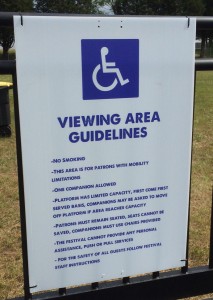
Sample guidelines for an ADA Viewing Platform
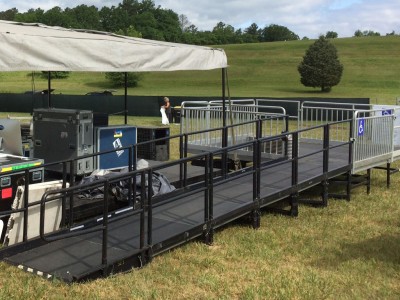
ADA Viewing Ramp positioned next to FOH
- What needs to be included in order to be compliant with the Americans with Disabilities Act? The ADA act of 1990 is a Federal law that prohibits, under certain circumstances, discrimination based on disability.
- Site Labor Needs
- Determine the proper amount of labor needed by calculating the time / manhours it will take to complete:
- Initial site visits / walkthroughs / measurements
- Building out / striking the perimeter
- Overseeing fencing, portalet, bike rack, tent build / strike
- Handling load-in / out ground protection needs
- Ensuring all site elements are in place
- Run of show team – putting out fires, replacing things as needed
- Hanging up signage (sometimes done in conjunction with the Creative / Signage teams)
- Placing out tables / tents / chairs / linens / power distro / site lighting
- Determine the proper amount of labor needed by calculating the time / manhours it will take to complete:
- Site Office Needs
- Determining what sort of office is needed for the site manager and their team – most smaller outdoor events, for example, will share a mobile office with the production team; larger festivals often have one or multiple trailers dedicated to the site team, with the production team in their own trailer(s).
- Ensuring there is a good place for the team to cool down or get away for a bit, especially during inclement weather / long workdays – usually having a tent outside the trailer is good enough, but if the event is dealing with extreme weather you’ll want to be able to have enough climate controlled space for the entire team, even if for a short period of time.
- Liquids – ice / coolers / waters
- Depending on the size of the event, organizing a dedicated person or team to handle all ice/water/soft drink distribution and refills; they would operate on their own channel and make sure everything is stocked at the start of each day, and then be more on-demand as people have needs throughout the day.
- Two Way Radios
- Determine all radio needs from all departments and place the order, taking into account the various extras that are often needed – speaker mics, in-ears, extra charging stations, and/or batteries. Larger events will have a dedicated radio person / team, usually from the vendor itself, that handles check-in/out, sets up the repeater, and has their own office. Smaller events will usually have these radios in the Site or Production trailers with an Office Manager overseeing the check-in/out process.
- Determine all proper radio channels for your event. A list of channels for a small to medium size event may include the following:
- Production
- Site
- Sponsorship
- Food / Art
- Bar Ops
- Security / Medical
- VIP / Hospitality
- Volunteers
- Client
- Chat
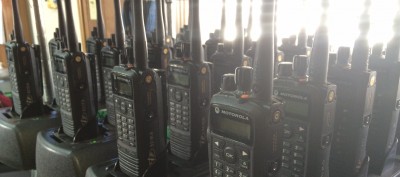
- Parking Needs
- Determine what types you will need:
- Guest Parking
- Staff Parking
- Artist Parking
- VIP Parking
- Parking Policies
- All for payment online or cash on-site or both?
- Ensuring all departments have their parking needs advanced to the site ops team
- Overflow parking plan
- Hiring a parking team
- Securing outside parking if needed
- Surface Lots
- Parking Garages
- Shuttles
- Working with the city to use local busses
- Hiring a shuttle company
- Finding off-site places for shuttles to load / unload
- Special VIP shuttles
- Determine what types you will need:

